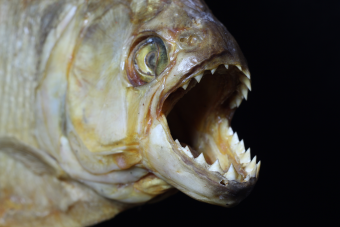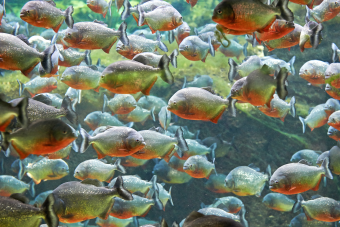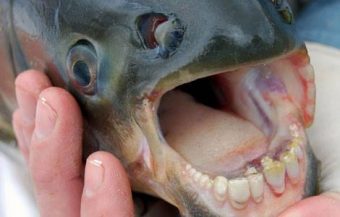Could Piranha Really Turn You Into a Skeleton in a Matter of Minutes?
 Alongside sharks, crocodiles and that fish people incorrectly believe can swim up a stream of urine if you pee in the Amazon, piranhas are amongst the most feared aquatic creatures on Earth. This is mostly due to the popularly held idea that a large and hungry enough shoal of piranhas could reduce you to nothing more than a skeleton in a matter of moments- an idea that, as it turns out, isn’t without precedent, but most certainly doesn’t tell the whole story about whether piranhas are actually dangerous to humans. (And, incidentally, if you live in the U.S., you are nearly four times as likely to be killed by a vending machine as a shark, with an average annual death rate of 2.18 for vending machines and 0.6 deaths from shark attacks.)
Alongside sharks, crocodiles and that fish people incorrectly believe can swim up a stream of urine if you pee in the Amazon, piranhas are amongst the most feared aquatic creatures on Earth. This is mostly due to the popularly held idea that a large and hungry enough shoal of piranhas could reduce you to nothing more than a skeleton in a matter of moments- an idea that, as it turns out, isn’t without precedent, but most certainly doesn’t tell the whole story about whether piranhas are actually dangerous to humans. (And, incidentally, if you live in the U.S., you are nearly four times as likely to be killed by a vending machine as a shark, with an average annual death rate of 2.18 for vending machines and 0.6 deaths from shark attacks.)
The first thing we should address is that, for the most part, piranhas pose no threat to humans and there are countless documented examples of people swimming in water filled to bursting with the fish without incident. In fact, to prove this point, one Dr. Herbert Axelrod even waded into a pool filled with the most dangerous of piranhas, the red-bellied piranha, wearing nothing but swim shorts. To put the final nail in the coffin of the myth, he even held out some fresh, bloody meat on a hook right in front of himself, which the piranhas eventually ate, but still left the giant meatbag standing just an arm’s length away, Dr. Axelrod, completely alone.
You see, though commonly thought of as voracious, carnivorous creatures with an unending hunger for flesh and who are driven mad by the smell of blood, piranha are omnivores (in that they can eat virtually anything) that are notably extremely timid. Even the most carnivorous types of piranha typically function more or less like the vultures of freshwater, generally feeding on dead or dying things, rather than the living, which sometimes bite back. (And, if you’re curious, see: Why Don’t Vultures Get Sick When Eating Dead Things?) The exceptions here are that they will eat very small fish, worms, and the like, which pose little threat to themselves.
In fact, the accepted reason for why piranhas team up in shoals isn’t so that they can overwhelm and consume large prey as pop-culture would suggest (traveling in such a large group actually means less available food for an individual piranha when prey are encountered), but as a means of protecting themselves from predators. Piranhas are well down in the food chain, commonly eaten by various birds, dolphins, caimans, fish larger than themselves and, of course, humans (apparently they are quite tasty, though Teddy Roosevelt noted they are also extremely bony).
One study conducted in 2005 even found that piranhas seemed to display something akin to nervousness or fear when left alone in a tank to the point researchers had to cover their enclosures with cloth so that the fish wouldn’t become too stressed. As pets, it’s also common for piranhas to hide when people are around their tank, and even sometimes continue hiding when you try to feed them, only coming out when the coast is clear. In large groups, piranhas have been observed to be much less skittish, though still have the default behavior of “swim away!” when encountering large creatures.
In the end, though research on piranha behaviour isn’t as robust as we might otherwise like, it is generally agreed that the piranha’s reputation is largely unfounded, with biologist Dr. Anne E. Magurran once wryly commenting that piranha are “Basically like regular fish. With large teeth.” (In fact, their name derives from the Tupi meaning “tooth fish.”)
This all said, piranha are exceptionally well-suited to ripping and tearing flesh, possessing sleek, muscular bodies allowing for extremely rapid bursts of speed, with teeth that are likened to knives and one of the strongest bites of any bony fish (relative to their size, one of the strongest bites of any vertebrate in the world). In specific regard to the red-bellied piranha, their bites are sufficiently strong enough to cut through a human finger bone like a “pair of bolt cutters” or easily remove a more sensitive part of a man’s anatomy in the blink of an eye.
We bring up this latter point because, while we (thankfully) couldn’t find any reputable sources citing an example of a piranha biting off a man’s pride and joy, there is a distant 60 pound cousin to the piranha, known as the pacu fish, which is infamous for killing two men in Papua New Guinea by biting their testicals off. The stories are circulated so much in Papua New Guinea that locals affectionately dub the Pacu “the ball cutter fish”. That said, it should be noted that the pacu’s reputation, like its cousin the piranha, is largely unfounded and another nickname they have is the “vegetarian piranha”. They typically prefer eating fruit and actual nuts, rather than the figurative ones attached to humans of the male persuasion. (There is some speculation that the ball biting pacu in question perhaps mistook the dangling men’s bits for literal nuts and so went for them.)
Whatever the case, the number of piranha attacks that occur in a given year is hard to quantify as the fish is endemic to rural areas of South America where such minor attacks are rarely reported on, and even when mentioned are generally exaggerated. As such, we only have ballpark estimates, with very large error bars, to go on. With that caveat noted, these piranha attack incidents are generally thought to be in the range of a few hundred attacks per year, mostly limited to small nips and bites. Confirmed feeding attacks are also rare outside of the dry season when food is relatively scarce. In fact, when researchers examined a large sample set of these confirmed attacks, they found that the bites were not typically to feed, but rather warning nips, given the timing of many of the attacks likely with the piranha trying to protect their eggs or with the humans in question stumbling into male breeding territories- both rare cases where piranha are known to get aggressive.
 In regards to supposed deadly piranha attacks, these often receive significant coverage from the media, but such incidents are exceptionally rare and more often than not, not accurately reported on. (News media exaggerating for effect?!?! Shocking!) For example, in 2015 it was reported that a 6 year old girl in Brazil had been eaten by piranhas after the boat she was in capsized. According to the coroner’s report though, while the girl’s body was found to have been partially consumed by piranhas, the bites occurred postmortem. The same can be said of numerous other supposedly “deadly attacks” reported in the last few years. As researchers Ivan Sazima and Sergio de Andrade Guimaraes, authors of the paper “Scavenging on human corpses as a source for stories about man-eating piranhas”, found, human bodies discovered partially consumed by piranhas are almost universally later found to have been already dead when the piranhas started nibbling. Again, piranhas are much more like the vultures, rather than lions, of freshwater, generally preferring to feed on dead or dying things. The reality is that piranhas simply aren’t in the habit of attacking living things many times their own size, at least, not under regular circumstances.
In regards to supposed deadly piranha attacks, these often receive significant coverage from the media, but such incidents are exceptionally rare and more often than not, not accurately reported on. (News media exaggerating for effect?!?! Shocking!) For example, in 2015 it was reported that a 6 year old girl in Brazil had been eaten by piranhas after the boat she was in capsized. According to the coroner’s report though, while the girl’s body was found to have been partially consumed by piranhas, the bites occurred postmortem. The same can be said of numerous other supposedly “deadly attacks” reported in the last few years. As researchers Ivan Sazima and Sergio de Andrade Guimaraes, authors of the paper “Scavenging on human corpses as a source for stories about man-eating piranhas”, found, human bodies discovered partially consumed by piranhas are almost universally later found to have been already dead when the piranhas started nibbling. Again, piranhas are much more like the vultures, rather than lions, of freshwater, generally preferring to feed on dead or dying things. The reality is that piranhas simply aren’t in the habit of attacking living things many times their own size, at least, not under regular circumstances.
So what about abnormal circumstances? Piranhas, as with any animal, can be driven to act out of their nature by desperation or opportunity. Beyond the aforementioned example of certain piranhas attempting to protect their eggs giving warning bites, while a piranha would normally otherwise give a human a wide berth, if that person is seriously injured, the particular carnivorous varieties of piranha may be tempted to take a quick bite to see if the dying creature in question tries to put up a fight. But even then, they typically will behave extremely cautiously.
Similarly, during the dry season, large numbers of piranhas sometimes become trapped in shallow pools as the water evaporates. If food becomes scarce, the fish may become more aggressive, not only willing to eat one another in such a scenario, but also willing to risk attacking something large when the alternative is to starve to death. However, it is noted as being very difficult to actually starve a piranha, with the fish being able to survive for many weeks without a significant source of food, given the right conditions. (The fact that they’re willing to eat just about anything helps.) So even in this scenario, they may well leave you alone out of fear that you might eat them instead.
But let’s say for a moment that you did starve an exceptionally large school of piranhas and then dropped a live cow or irksome British super-spy into the water- how long would it take for the piranha to skeletonise them? It’s generally thought it would take about 300-500 piranhas about five minutes to completely devour a typical adult human, give or take depending on how hungry they were to begin with. (If they are not hungry, don’t be surprised if said piranha mostly ignore even the bloodiest of carcasses at first.)
On the former point, you don’t have to take our word for it, just ask former United States President and one of the manliest men in history, Theodore Roosevelt. (Lest you think we’re exaggerating, see our piece: In Which Theodore Roosevelt Makes Men Everywhere Feel a Little Less Manly. Among his numerous manly exploits, this is a person who once got shot in the chest, but the bullet literally stopped cold when it encountered his ample chest muscle, lodging itself within it. Rather than seek medical attention, directly after being shot, he went ahead and gave a 50 page long speech he’d previously planned, changing the beginning to “Ladies and gentlemen, I don’t know whether you fully understand that I have just been shot; but it takes more than that to kill a Bull Moose.”)
In any event, in Roosevelt’s many exceptionally well documented world travels, he once witnessed such a piranha frenzy scenario play out while visiting the Brazilian rainforest in 1913. According to his book, Through the Brazilian Wilderness, Roosevelt was privy to a display of the piranha’s appetite by local fishermen who pushed a live cow into the water in front of the President. He watched in horror as the fish tore the bovine apart in a matter of a few moments, reportedly leaving behind nothing but a skeleton. Roosevelt went on to write at length about the fish at a few points in this work, describing it as the “embodiment of evil ferocity”, noting the fish’s “short muzzle, staring malignant eyes, and gaping, cruelly armed jaws”.
He went on to note,
They are the most ferocious fish in the world. Even the most formidable fish, the sharks or the barracudas, usually attack things smaller than themselves. But the piranhas habitually attack things much larger than themselves. They will snap a finger off a hand incautiously trailed in the water; they mutilate swimmers—in every river town in Paraguay there are men who have been thus mutilated; they will rend and devour alive any wounded man or beast; for blood in the water excites them to madness. They will tear wounded wild fowl to pieces; and bite off the tails of big fish as they grow exhausted when fighting after being hooked.
Roosevelt’s widely read account of the piranha is the reason so many today believe piranhas are murderous killing machines that will strip you to the bone the second you step into the water with them.
So what had caused the piranhas to act so abnormally in the case of Roosevelt’s cow story? Unbeknown to Roosevelt, the local fishermen he’d met with had specially blocked off a section of the river with nets and had spent several weeks filling the makeshift pond with hundreds of hungry piranhas. The fishermen were well aware of the piranha’s impressive ability to rend flesh from bone when they are starving and set up the scenario to impress Mr. Roosevelt. He then unknowingly went on to report it as something piranhas do all the time instead of an example of what it can do under a very specific set of circumstances.
The thing to note here is that a sizeable enough group of piranhas that are sufficiently hungry enough could strip a person to the bone in minutes, if you accidentally fell into the water and splashed around a lot (splashing attracts them). However, given piranha are happy to eat just about anything that has even the smallest of nutritional value and they can go an exceptionally long time without food, this “starving piranha” scenario is very unlikely and you’d probably be just fine swimming around in a lake filled with them. And even if piranha do nip at you, it’s usually just on the ends of your extremities and leads to no further biting. So I guess for your own irrational sense of well-being, if you’re a man and want to swim with the piranha, maybe wear some tighty whities under your shorts just to be on the safe side…
If you liked this article, you might also enjoy our new popular podcast, The BrainFood Show (iTunes, Spotify, Google Play Music, Feed), as well as:
- The Parasite that Becomes a Functional Tongue
- Do Fish Actually Like Worms?
- Can Lobsters Really Not Die of Old Age?
- Do Earwigs Really Lay Eggs in Your Ears?
- Is It True That a T-Rex Couldn’t See You If You Didn’t Move?
| Share the Knowledge! |
|








Quoting from the (otherwise very interesting and informative) article …
“We bring up this latter point because, while we (thankfully) couldn’t find any reputable sources citing an example of a piranha biting off a man’s pride and joy, there is a distant 60 pound cousin to the piranha, known as the pacu fish, which is infamous for killing two men in Papua New Guinea by biting their testicals off.”
As now seems to be becoming a DAILY — not just a frequest — event, the writer shamelessly exhibits his case of “TIFO Fever” — the visible symptoms of which are an obsession with matters sexual and/or scatological. It was of NO serious value whatsoever — and it was in fact detrimental to young readers — to mention the above irrelevant facts about private body parts.
Oh, and by the way … “a man’s pride and joy” is his wife and their children (or, if he is unmarried, his deeds that have benefited mankind). Only an immature, self-absorbed, egotistical person would think of some mere body part of his/hers as a “pride and joy.”
Grow up, little boys and girls who own or write for, Today I Found Out! Get it out of your system today, and become real men and women!
… *yawn* …
Relax dude
double yawn.
pc much? geeze. I thought todayifound was aiming to be cheeky.